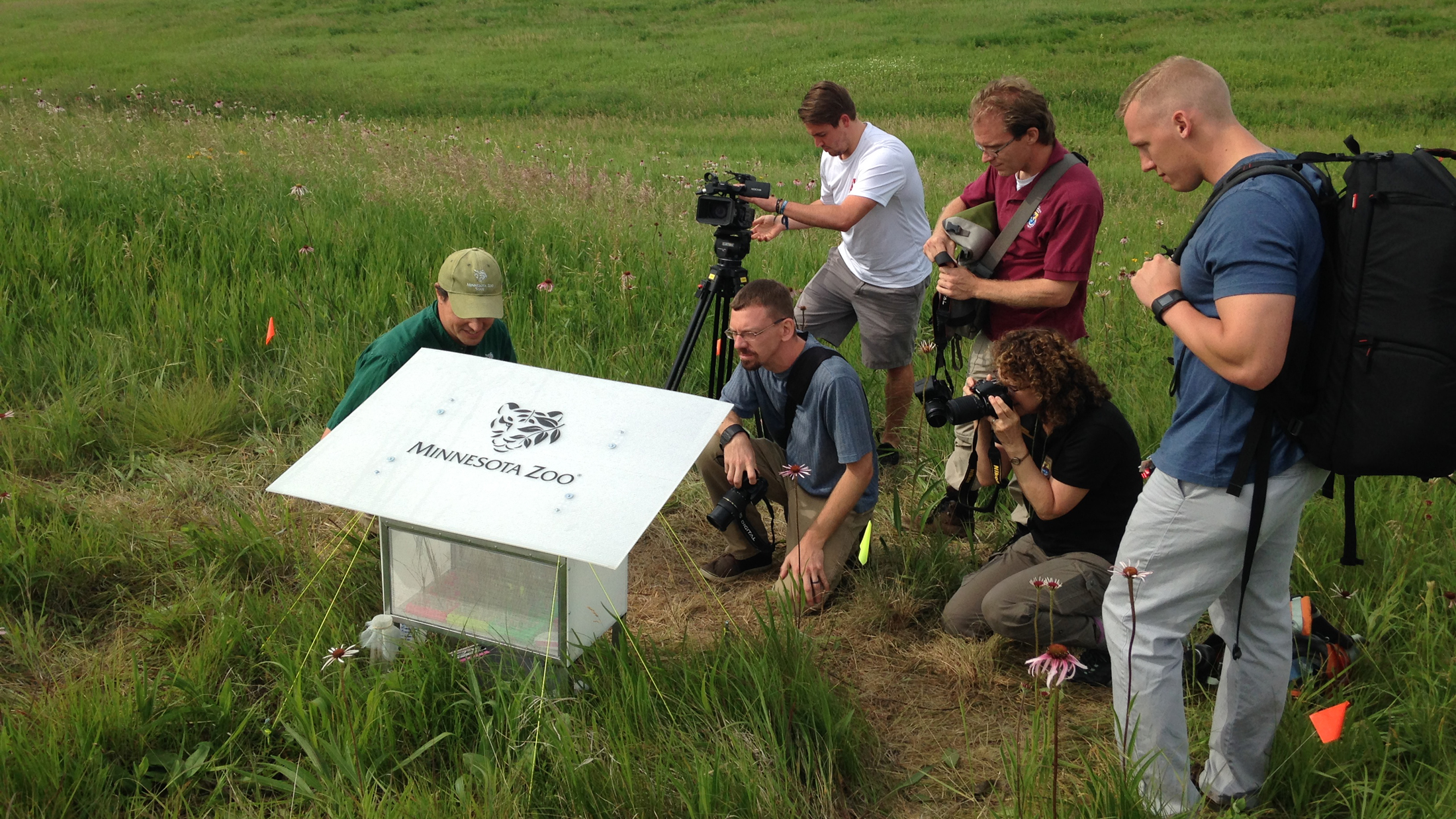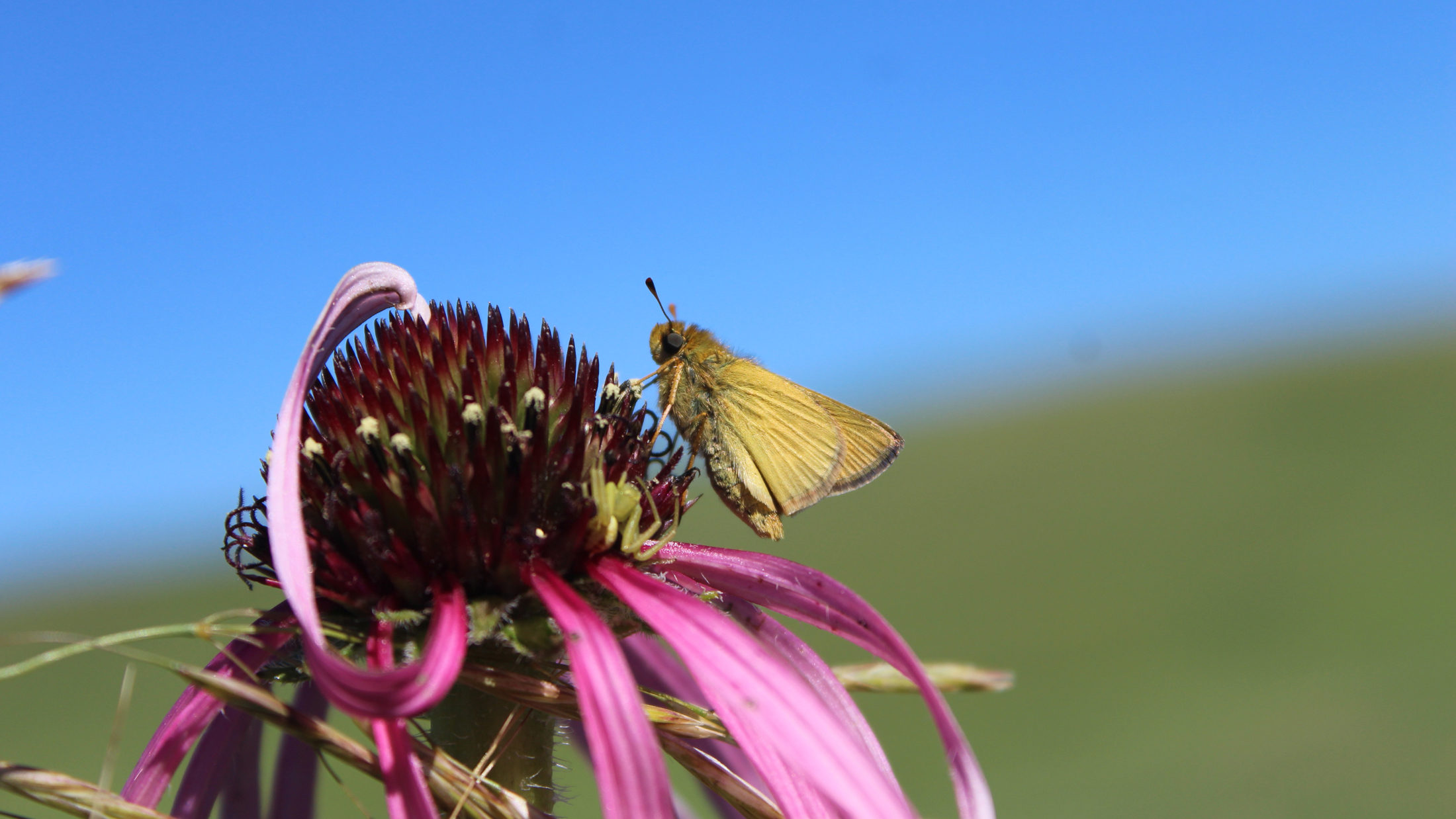There is nothing quite like watching a butterfly emerge from its chrysalis to make you feel like an excited kid again. This summer I witnessed an awe-inspiring event as federally threatened Dakota skippers (Hesperia dacotae) emerged as butterflies and were reintroduced to a Minnesota prairie. About 200 adult Dakota skippers were released on The Nature Conservancy’s (TNC) Hole-in-the-Mountain Preserve in late June and early July this year in an attempt to reestablish a population on this site that was once a stronghold for the species.
Dakota skippers only spend two weeks as adult butterflies flitting about the prairie, and the rush and excitement of the emergence and release of the adults at Hole-in-the-Mountain is over for the year. We had about three weeks to watch them explore their new home, encounter each other in a natural setting, mate and lay eggs. The eggs hatched this summer, and they will spend the Minnesota winter as caterpillars in homemade grass shelters near the prairie soil. Pretty hardy critters. Now the waiting begins.
Reintroduction of threatened and endangered species to the wild is a complicated process, and the partnership among The Nature Conservancy, the Minnesota Zoo, the Minnesota Department of Natural Resources and the U.S. Fish and Wildlife Service helped make this one possible. As the reintroduction got underway this summer, Dakota skippers had their own paparazzi. The event brought a lot of attention to the plight of prairies and prairie butterflies.

But reintroduction efforts often come with many questions.
Why was the reintroduction effort necessary? Many species of butterflies that depend on native prairie for their survival have declined over the past decade, and in 2014 the Dakota skipper was listed as threatened on the Endangered Species Act. The species has disappeared entirely from Illinois and Iowa and is currently only known to occur in small, scattered populations. Reasons for the declines in prairie butterflies are not entirely clear. Across its range, the loss of greater than 97% of the northern tallgrass prairie has certainly played a role (Samson et al. 2004), but at the site scale, pesticides, pesticide drift and climate change are also likely contributors.
If we don’t know why they disappeared why reintroduce them now? It is true that we do not know the reason or reasons that Dakota skippers disappeared from Hole-in-the-Mountain to begin with, and it is possible those threats still exist on the site. However, there are two good reasons to begin reintroduction now. The first is that breeding too many generations in human care can increase the risk of individuals acquiring characteristics that would reduce their survival in the wild. The second is that reintroduction efforts now, paired with monitoring of the population and habitat may help us begin to understand what factors promote success or decline in the population. This knowledge will benefit the reintroduced population but hopefully remaining populations in the wild as well.

Where did the Dakota skippers released at Hole-in-the-Mountain come from? The (great-great) grandparents of the butterflies that were released lived on a native prairie hillside in South Dakota. After a few years of successful conservation breeding at the Minnesota Zoo, their offspring were ready to repopulate a native prairie in Minnesota.
Why so much focus on one species? It is true that Dakota skippers are just one of many prairie butterfly species in decline. Why should we put so much effort into one species? Doesn’t it come at the expense of efforts for others? Our hope for the Dakota skipper reintroduction efforts is that we can use this species and this process to learn how to benefit all prairie butterflies and a diversity of prairie insects. For example, the Minnesota Zoo is refining how to rear and breed butterflies, and as land owners, TNC is learning how to best manage the prairie for thriving populations of Dakota skippers and other prairie insects. Additionally, the reintroduction process itself will teach us about movement and dispersal that will help us better design and implement landscape scale conservation for populations of prairie obligate butterflies. Research and monitoring is taking place throughout the process to address these questions.

How do we determine success? The definition of success for this project is a self-sustaining population of Dakota skippers occurring at Hole-in-the-Mountain. However, it will be a number of years before we can make this determination. Releases are planned at Hole-in-the-Mountain for at least the next two years. Only after releases have been completed will we be able to determine whether the population is sustaining itself. Five years of stable or increasing Dakota skipper numbers at Hole-in-the-Mountain will be considered the start of a self-sustaining population.
In our careers as conservationists, we work to save habitats and species and hope that reintroductions are not necessary. However, when species begin to disappear too quickly sometimes captive rearing and reintroduction are the best option. Dakota skippers are back in their home after a decade of absence and their presence in the landscape again gives us both hope and a mechanism to learn how to do better for other species.




Co-dos for everyone interested in the smaller T&E species. This is great for reintroduction of butterflies and moths, and maintaining diversity. I hope monitoring and future re-introductions will prove successful for this species and other species in need of saving. Is there projects planned to determine what is causing the declines?
Hi Donna, Thank you for your interest! The research and monitoring mentioned in the article will help to answer questions about what caused the declines and how best to manage habitat for Dakota Skippers going forward.
Now these people need to get involved with the Poweshiek Skipper. A number of us spent a whole season trying to locate the Skipper (I believe, correctly a skipperling) where it was first found, in Poweshiek County (Grinnel), Iowa. With many man-hours in the field. It was determined the species no longer existed in its “place name”. They can be found in the Canadian prairie provinces, although nowhere common. Perhaps this might bee another project for these willing individuals. Larry – Gambier, OH
I have grown up in the Los Angeles area where similar looking butterflies flourished and were plentiful in our parent’s backyard and surrounding neighborhood. It has been many many years since I have seen any traces of such butterflies. Did Dakota Skippers once inhabit portions of Los Angeles or are the ones I’m thinking about belong to a different species?
I have been a religious donor to the Conservancy since 1986…the varied programs TNC have been involved in and the successes you have achieved over the years are greatly appreciated and need to be recognized by all that inhabit this special planet of ours. Keep up the great work!
Hi Robert, You were most likely seeing a different species. Here is some information from the USFWS on Dakota Skippers, including their historic range: https://www.fws.gov/midwest/endangered/insects/dask/daskFactSheet.html
What a great effort. Keep up this wonderful work. Every species is important.
Corridors needed South to North and East to West for the Butterflys migration to save locations. Great Article. Heroes saving the Butterflys. Beautiful creatures. Scientist are Brilliant.
I’m going to stop reading right now, right here, and go to bed with good news in my mind and hope in my heart. Thank you! And I look forward to reading more good news about the Dakota Skipper, and prairies, in the hear future.
Nature Matters, too!!
The prairie is absolutely beautiful! That in itself is justification enough to preserve it. By reintroducing a species as important as a pollinator makes this fact even more significant. I believe that any thinking human being should support the efforts of preservation without any hesitation.
The number of endangered species has been increasing in the past decade. It could be beause of Pollution and climate change but its surely a warning that its time to take corrective steps as this is not a good sign for humans. Your article on Dakota skippers gave me an insight that even butterflies are in endangered species but I am glad some corrective steps are being taken.